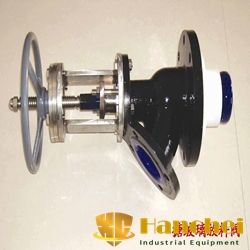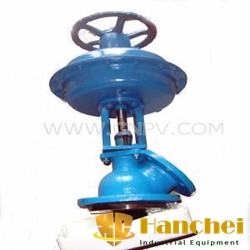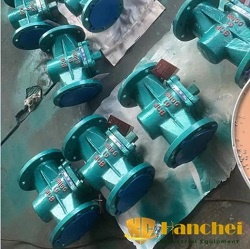Products >> Chemical equipment accessories and fittings >> Glass lined discharge bottom valve
Glass lined enamel discharge bottom valve
Glass lined Enamel discharge valve, pneumatic enamel discharge valve is a vitreous glaze with high silicon content. It is made by coating metal tires at a high temperature of about 900°C. It has good mechanical properties and corrosion resistance, can prevent the substitution of media and metal ions to affect the pollution of products, and has a smooth surface, abrasion resistance, and certain thermal stability. Suitable for glass-lined discharge valve with design pressure P≤0.6Mpa and working temperature t≤150℃. The technical conditions of the valve should meet the requirements of HG5-16-79. In addition to phosphorus and phosphorus light media, hydrofluorocarbon, hydrochloric acid, sodium hydroxide, potassium hydroxide, this valve can withstand various acids, alkalis, salt solutions and organic solutions. It is widely used in chemical, petroleum, metallurgy, pharmaceutical, dye, food processing and other industries.
Specific parameters:
1. Corrosion resistance resistance to general inorganic acid, organic acid weak lye (P≤60℃ PH≤12) and organic agent medium. It is better than stainless steel in strong corrosive media such as hydrochloric acid, nitric acid and water. It is strictly forbidden to use fluorine-containing ionic liquids (such as HF, etc.), nor to use strong alkalis and phosphoric acid (temperature>150°C, concentration>30%).
2. Heat resistance, allowed to be used between -30°C and +240°C (temperature resistance is less than 120°C).
3. HG5-16-79 glass-lined discharge valve has a smooth surface. It is not easy to stick materials and easy to clean.
4. Insulation: The glass frit has good insulation, and the glass with a thickness of 1mm will not be broken down and conduct electricity under the high voltage of 2000 volts.
5. Impact resistance: The impact resistance is as small as 2500 g/cm, so the impact of hard objects should be avoided when using it.
6. Withstand voltage: 0.6Mpa
Precautions for maintenance and installation and use:
1. Asbestos or PTFE sheet and other soft pads must be used wherever it is in contact with the porcelain surface during installation. Do not use tools to impact or rub against the porcelain surface, let alone shovel with metal tools.
2. Tighten the screws with equal force around the sides when tightening the screws to prevent uneven force on the porcelain surface and cracking of the porcelain. The screw rod of the discharge valve should be kept lubricated frequently to prevent rust.
3. The flowing medium can only be liquid, and no hard particles can be mixed into the liquid to prevent the porcelain surface from fluffing or clogging, as well as opening failures and so on.
4. When installing, pay attention to whether the screws of each part are balanced and whether the lifting (movement) is flexible.
5. The seals on the enamel surface should be kept in the center. The pressure is even to prevent leakage.
6. If there is any leakage during use, check whether the sealing device is correct or not. Do not use iron bars or levers to tighten the handle wheel to avoid damage to the parts.
7. When the discharge is blocked, metal rods or hard tools can be used to dredge, and metal rods or hard tools are not allowed.
8. Avoid alternating use of acid and alkali media (except for neutralizing reaction media) to avoid shortening the lifespan.
9. According to the performance of the medium and the service life, the PTFE sealing ring at the neck of the valve body and the PTFE sheet on the orifice should be checked frequently. If it is found to be damaged, it should be replaced and reused in time.






Previous Product:PFA PTFE Lined plug valves acid resistance
Products Category
Contact Us

Name: Ivan
Tel: +86 533 5580757
Mobile/Whatsapp: +86-13054986747
E-mail: [email protected]
WeChat: +86-13054986747
Whatsapp: +86-13054986747
Add: No.7 Zhangdian High-tech zone, Zibo City of Shandong province, China
 РУССКИЙ
РУССКИЙ ENGLISH
ENGLISH









 WhatsApp
WhatsApp  Mail inquiry
Mail inquiry